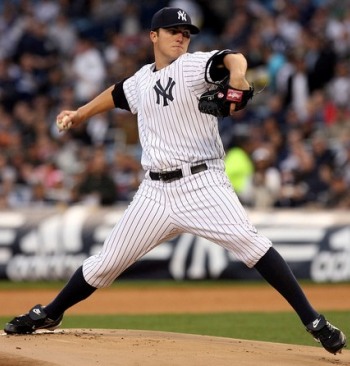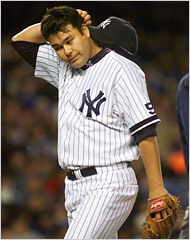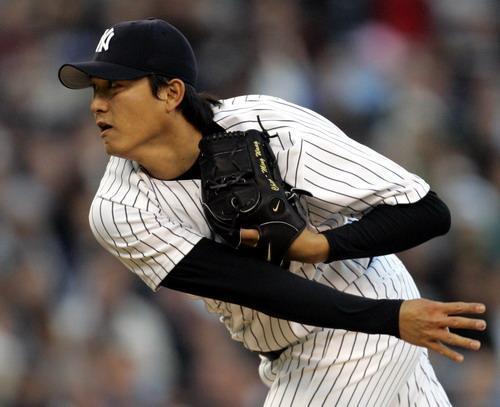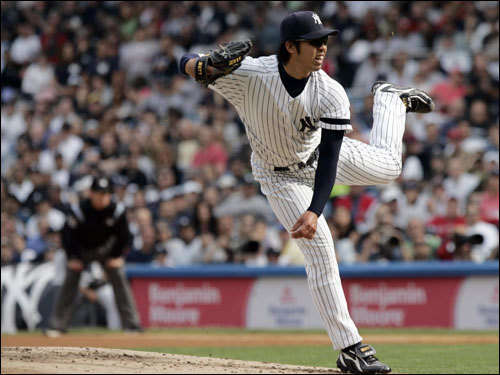The Yankees won their 102nd game of the season last night and will easily have the best record in baseball this year, for whatever that's worth. They sent the Royals reeling to their 94th loss of the year, which is no small feat considering that they've got the best pitcher (Zach Grienke) and one of the best closers in the league, as Joe Posnanski points out.
On the plus side, the athletic trainer who may or may not be to blame for many of the Royals' woes over the past two decades is finally retiring, so things may be looking up. But that was little consolation last night.
Unfortunately for the Royals, both Greinke and Soria had just pitched on Sunday, and the latter of those threw 46 pitches, making him "not available" for Tuesday night's game, according to Royals Manager Trey Hillman. “He’s just a little sore and needed another day,” said Hillman, according to Bob Dutton of the KC Star.
In his absence, journeyman choke artist reliever Kyle Farnsworth coughed up the lead and lost the game, though in his defense, it's not like he really got hit hard. After striking out Brett Gardner, he gave up an infield single to second base by the Yankees' 3rd string catcher, Francisco Cervelli, who has spent most of the season in AA and AAA.
Next came the only solid hit he gave up all night, a single to pinch-hitter Eric Hinske, on a 2-1 pitch, which moved Cervelli to third base. The good news was that Farnsworth retired the next batter, Robinson Cano, despite going to 3-0 on him first. The bad news was that it was a sacrifice fly that tied the game and blew the Save for what would have been rookie Anthony Lerew's first career win in the majors.
With Johnny Damon at bat, Hinske then decided that since it had been exactly one year and one day since he had attempted to steal a base in the majors, he was due. So he ran and not only made it to second, but went to third on catcher John Buck's throwing error. Damon was then walked to get to the rookie, Juan Miranda, which makes some sense, especially when you consider that Miranda's career strikeout rate in the minors is about once every four at-bats.
Unfortunately for Farnsworth and the Royals, Miranda did not strike out. He put the ball in play, which bounced off the pitcher's shoe into foul territory and allowed the winning run to score.
These were not the Mighty Yankees beating up on the Lowly Royals. These were two back-up outfielders, a 3rd-string catcher and a 4th string firstbaseman who stepped in something lucky on the way to the ballpark yesterday. An infield single. Another single. A sac fly, and the game was tied. A steal. A throwing error. An intentional walk. Another infield single, and the game was over before the Royals knew what hit them. Joe Morgan would be so proud.
You can blame Farnsworth for not throwing enough strikes, or for not getting enough fly balls, though with the reputation of New Yankee Stadium, you can see why he might want to keep the ball on the ground. But infield singles happen sometimes, and so do throwing errors, and neither of those things was really Farnsworth's fault.
They were Hillman's fault.
How? Because he didn't bring in in his best reliever to nail down a close game against a very, very good team. Hillman said that he couldn't bring in Soria because he had thrown a lot of pitches two nights before, but was that necessarily true?
Curious, I wondered whether Hillman typically gave his relievers two or more days of rest after throwing that many pitches, so I looked it up. it turns out that there have been 26 times this season in which a Royals reliever has thrown 40 or more pitches in an outing. This is no great surprise, as relievers often rack up significant pitch counts in an outing.
The real question is how often Hillman tends to give such relievers two or more days of rest between uses, and the answer to that is, "Usually, but not always." There have been six occasions on which Hillman has chosen to use a reliever who threw 40+ pitches with just one day of rest. Those pitchers were
Yasuhiko Yabuta
Carlos Rosa
Victor Marte
Ron Mahay
Jamey Wright
Sidney Ponson
The results were not encouraging.
In those six high-pitch count, low-rest outings, these Royals relievers provided little relief at all, allowing nine runs on 12 hits (including three homers) in just 5.2 innings, for a nifty 14.31 ERA. Hillman almost certainly did not know this, at least not with this degree of detail, as I doubt he would take the time to pore over the stats and box scores as I did.
However, Hillman undoubtedly must have known that his bullpen has not generally done very well when he's tried to push the usage envelope like this, especially since the last time it happened was less than a week ago. Yabuta was brought in to pitch on 26 September after having thrown 53 pitches just two days before, and he promptly allowed four runs to score while retiring only one batter. Hillman hasn't called upon him since.
Joakim Soria, however, is no Sidney Ponson or Ron Mahay. 
Those six pitchers have a combined record of 6-14 with a 6.03 ERA with the Royals this year, and none of them is the kind of top-flight pitcher that deserves to be handled with kid gloves, as Soria is. So you have to ask whether these guys pitched poorly in those outings because they needed more rest, or simply because they needed more talent, something even the intrepid Trey Hillman cannot provide.
Wright and Ponson are 30-something journeymen, and lousy ones at that, both with career ERAs over 5.00. Mahay is a veteran LOOGy, and while not a bad one overall, he was bad enough while in Kansas City (4.79 ERA) that they released him, whereupon the Twins picked him up and he immediately started getting batters out again. Of course. On the other hand, that 4.79 is almost exactly the same as the team's 4.74 composite ERA, so maybe Hillman jst didn't like him or something.
The other three, Rosa, Marte and Yabuta, are all technically rookies, but Yabuta is 36 and pitched professionally for more than a decade in his native Japan. At 28, Marte isn't young either, and he pitched for a few years in Japan before the Royals acquired him.
Even Carlos Rosa, though not yet 25, is no spring chicken in baseball terms, having pitched professionally since he was 17. He had Tommy John surgery and missed all of the 2005 season, and his minor league track record is spotty, but he could top out as a back of the rotation starter, but no more.
But Soria is not a jourrneyman LOOGY or a veteran re-tread or anything of the sort. He's a 25-year old flame-throwing closer who's saved 88 of the team's otherwise pathetic 208 wins in the last three seasons, and who is still under the team's control (subject to arbitration) for the next three seasons. He's a hugely valuable commodity, and you don't throw caution to the wind with someone like that, not in a completely meaningless game in late September.
Soria has never pitched with just one day of rest after throwing 40 or more pitches in his three-year major league career. For that matter, he'd only thrown 40+ pitches once before, on September 1st, earning a 2-inning Save against the Oaklands, but then did not pitch again until the 5th. He has thrown 35+ pitches and some back on only one day of rest a few times in his career, and with some success, but there's a big difference between 35 pitches and 46 of them, I would imagine.
So you can't blame Hillman for keeping him out of the game, especially if Soria himself said that he was still a little sore. But that doesn't mean we can't ask the question of why it was necessary for him to throw 46 pitches two days ago in the first place.
In that game, Greinke had allowed one run on seven hits and two walks while striking out eight in seven innings of work. At that pooint, he had thrown just 97 pitches, and had fanned Denard Span and Orlando Cabrera, neither of whom is especially prone to strike out, to finish the 7th.
Greinke has averaged 106 pitches per start this year, and that number would be higher if not for a couple of artificially shortened games. He's thrown 110+ pitches 13 times this year and had not thrown even 100 pitches in over two weeks, so his arm presumably could have handled another inning.
In any case, with a 4-1 lead in the eighth inning, Hillman could have called on Marte or Rosa or Dusty Hughes or Roman Colon or maybe even Farnsworth, though he had thrown a dozen pitches the night before and it says here that Farnsworth is lousy on short rest. But whether Hillman wanted to stick with Greinke or bring in one of those other guys to protect a three-run lead in the eighth is not the point.
The point is that the one thing he should not have done was to ask his best reliever to get six outs to protect a big lead in a meaningless game. Not because he couldn't do it. He could and most certainly did. But because it would most likely make him unavailable the next day, and perhaps the day after that. Which is exactly what happened.
Even if Hillman didn't expect Soria to need 46 pitches to get out of the game, he might have guessed that Soria would use at least 25 or 30, and that this would make him off-limits for the next day's game. As it happened, Soria wasn't exactly sharp, as he hadn't pitched in five days, and he allowed four hits and plunked a batter in those two innings, though he escaped without allowing a run.
And because Soria spent two innings protecting a three-run lead against the Twins, who have averaged just 1.42 runs per game in the 7th inning or later this season, he was unavailable to protect a one-run lead against the Yankees. The same Yankees who not only lead all of MLB in run scoring overall, and have the best home record in MLB, but who have averaged over two runs per game in the late innings this year, have come from behind like a jillion times already this season.
Nah, we won't need our closer against those guys.
Maybe things wouldn't have ended any differently. After all, it was mostly bad luck and some bad fielding that did the Royals in, and that could happen to anybody. OK, so Farnsworth somehow attracts this kind of bad karma more than other pitchers, but still. Soria might not have been any luckier.
But Soria is a much better pitcher than Farnsworth, and given the right circumstances, he likely would have retired the Yankees, especially the 3rd and 4th stringers, with little trouble. We'll never know, of course, because on Sunday Hillman inexplicably used his bullpen like it was the 7th game of the World Series.
Thanks for #102, Trey.



































